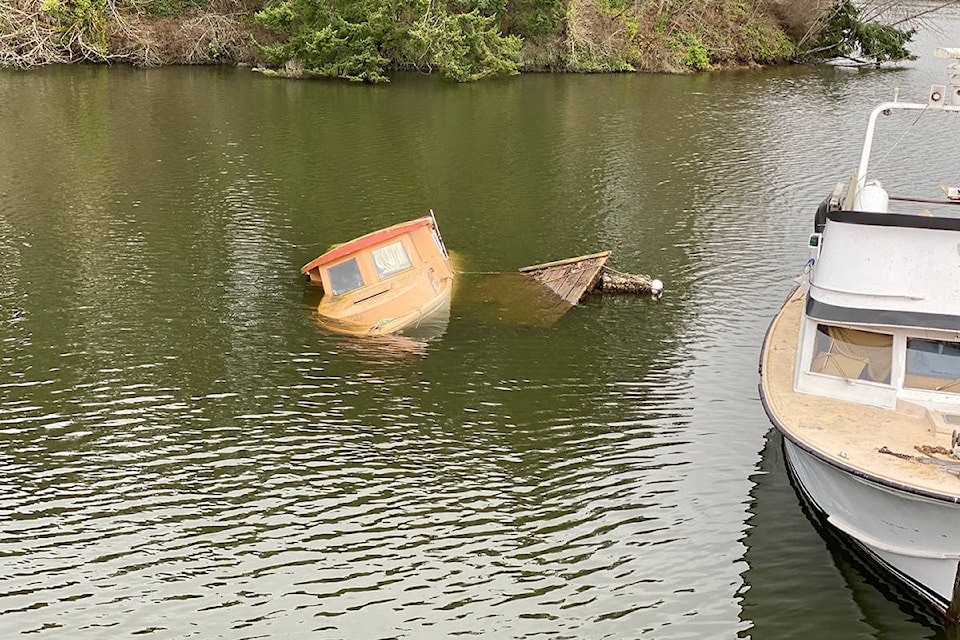While abandoned boats have plagued the Gorge and Selkirk Waterways for decades, a recent sinking of one has environmental advocates upset.
Last week a boat sank in the Selkirk Waterway, where it has sat without response ever since.
The boat is not the first to sink in the area; there were similar incidences in 2016 and 2018, as well as a regular fleet of half a dozen floating boats seen in an area.
“I’m furious. Boats continue to anchor in a bird sanctuary and now another has sunk,” wrote Valerie Elliot, a local resident and environmental advocate in a letter to Victoria’s mayor and council. “This boat that has sunk in the Gorge has remained there for over a week… Who is responsible for this boat’s removal? It has been anchored for years in a migratory bird sanctuary. Who is responsible to monitor and take action for this bird sanctuary?”
That is a bigger question than many may have anticipated, often leading to a hot-potato scenario.
John Roe, a founder of the Dead Boat Society, which has helped remove 89 boats from across the Capital Region in the last year, and the Veins of Life Watershed Society, shared a list of all the levels of government and the different agencies who can take up responsibilities for derelict vessels.
“It’s a quagmire of who is supposed to respond to what,” Roe said.
ALSO READ: City of Victoria wins injunction allowing removal of derelict boats from Gorge
The list includes 17 separate governments or government bodies, including local municipalities, First Nations, Members of the Legislative Assembly (MLAs) and Members of Parliament (MPs); six federal agencies including Fisheries and Oceans Canada, Transport Canada, Environment Canada and the Canadian Coast Guard, and four provincial ministries.
Different situations warrant the involvement of different agents.
The City of Victoria holds a lease for the Selkirk Waterway, becoming managers in the process. In March 2018 it won a B.C. Supreme Court ruling to have the authority to regulate the waterway, including the ability to prohibit live-aboard vessels.
“Since last March when the court upheld the City’s regulations for recreational mooring in the Gorge Waterway, we have been actively managing the area and have seen a major improvement over what it was like two years ago. And we’re not letting up,” said Bill Eisenhauer, head of engagement at the City of Victoria.
“City bylaw officers make regular visits to the area and contact all boaters that come into the area to make them aware of the regulations for short-term moorage. Things have been working very well, except for a few remaining illegally moored vessels.”
Eisenhauer said that most boats have moved off, with the exception of four which continue to holdout. Presently, the City is seeking out enforcement orders to remove these boats.
This includes the boat which sank last week, which has been there and acted as a home to someone since at least 2009, Roe said.
“It’s had various docks over the years, and the guy on board would sometimes hop between one boat and another,” Roe said.
ALSO READ: More than a dozen boats to be removed from Victoria waters
Now that the boat sank, however, it has become an environmental concern and in turn become a federal and provincial issue.
“Any boat is a pollutant; the paint has lead and zinc,” Roe said. “And boats are made of nasty things, like metal and glue, and can have oil on board.”
That is aside from anything else a boat had on board, such as jerry cans full of fuel.
Now the first step is for the Canadian Coast Guard to send an environmental response officer to analyze what is called a “Vessel of Concern” before making further recommendations.
Black Press Media reached out to the Canadian Coast Guard to confirm if a report had been received, but no one was available for an immediate response.
After writing several assessments the Coast Guard will then contact several other agencies, including Transport Canada and Environment Canada, as well as attempt to track down the owner of the vessel.
Roe believes that somewhere down the line, he and the Dead Boat Society will be responsible for the removal of the craft.
“We get the last of the last, if any other agencies can’t deal with it,” he said. “I suspect we’ll end up being the ones removing it.”
READ MORE: CRD seeks more funding to remove abandoned boats
A federal program called the Abandoned Boats Program, which has provided funding to help with the cause in the past, has yet to be renewed by the federal government. Through this program, Transport Canada provided 100 per cent of the assessment costs but only 75 per cent of removal and disposal costs. In recent years, the Capital Regional District and local municipalities had to foot the bill for the remaining 25 per cent, totalling between $150,000 and $200,000.
Roe said that if the Dead Boat Society ends up taking over the removal, it likely wouldn’t be until the summer and only after several reports are sent from the group to different levels of government. Following approval, the Dead Boat Society will have to post a notice on the boat, legally seize it and dispose of it – a process which could take up to eight months.
Like us on Facebook, send a Tweet to @NicoleCrescenziand follow us on Instagram
